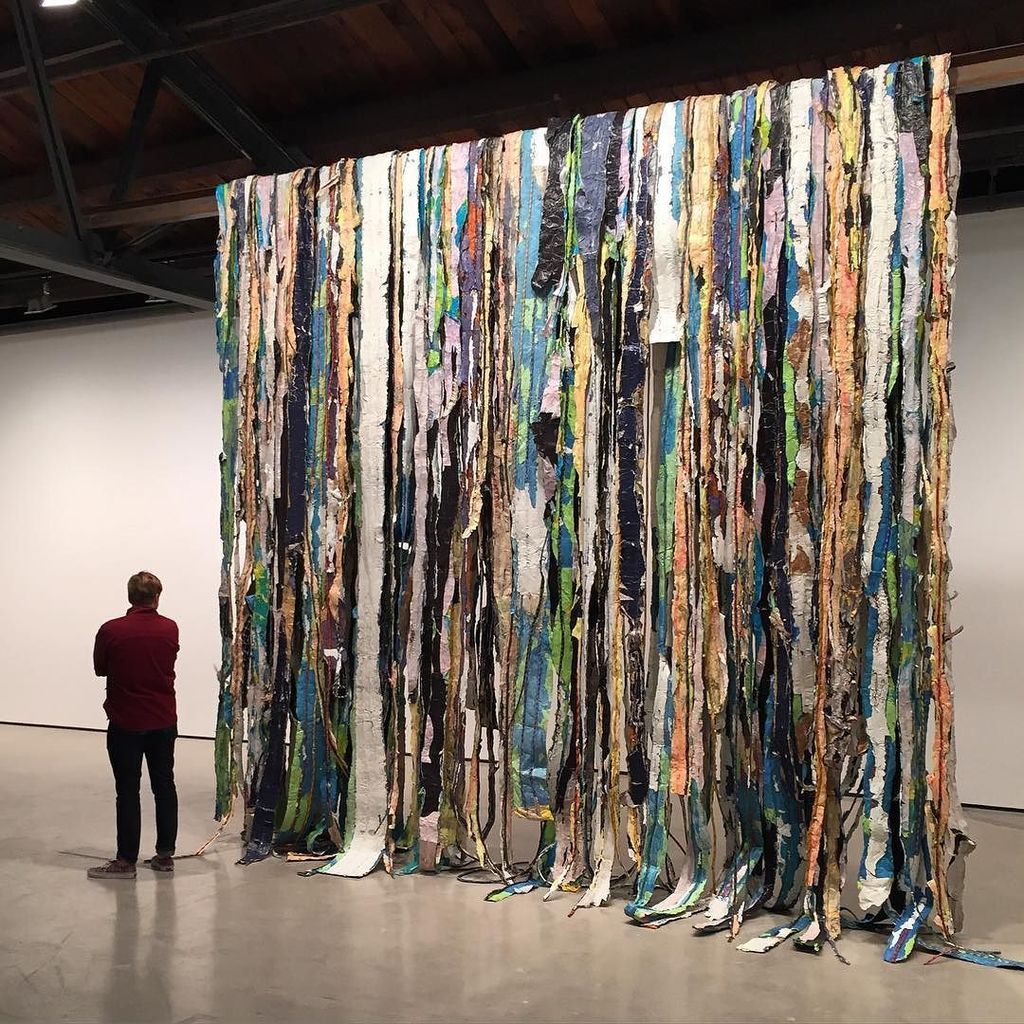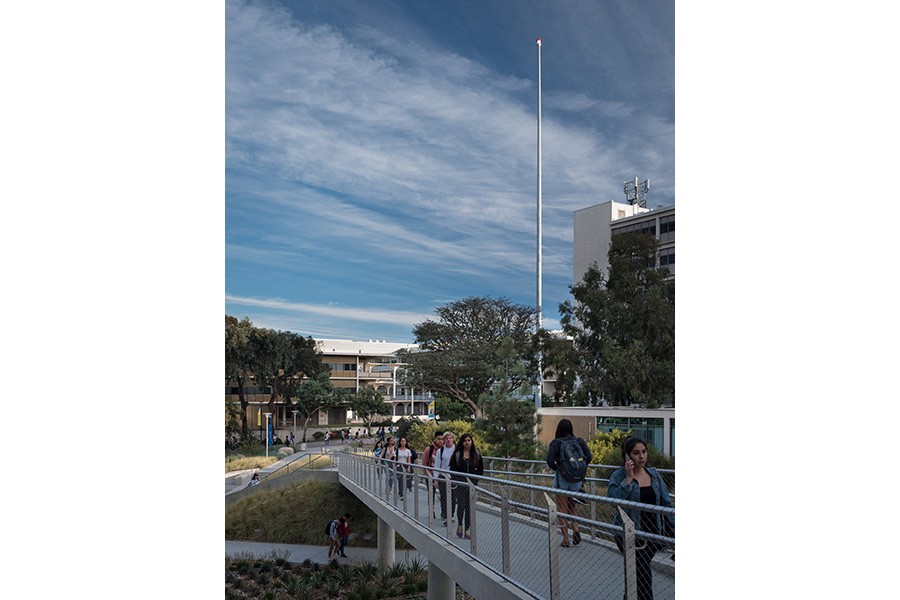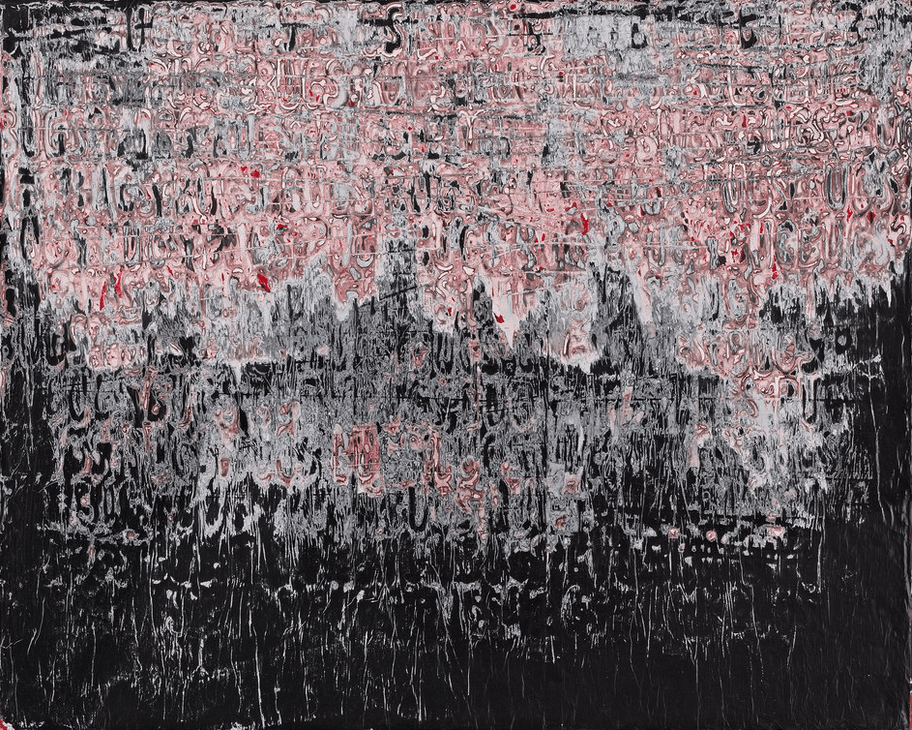Bradford is known for his mesh abstract paintings combining collage with paint.
Mark Bradford is known primarily for his large-scale abstract paintings, which are mainly devoted to issues of class, racial, and gender inequality. The artist raises critical issues for American society.
Mark Bradford’s paintings resemble aerial photographs and road maps. He creates works using the collage method from fragments of street advertisements, posters, newspapers, from various pieces of the urban landscape.
What one should know about Mark Bradford

The artist was born in South Los Angeles. His mother owned a beauty salon. As a child, Mark Bradford often helped his parents in their business, and after graduating from high school, he received a hairdresser’s license and officially began working with his mother in her salon.
When the future artist was 11 years old, his family moved to the so-called Los Angeles’ White neighborhood Santa Monica.
In 1991, at the age of 30 years old, he enrolled in an undergraduate degree at the California Institute of the Arts. In 1997 he got a master’s degree at the same institute.
In May 2017, Mark Bradford was introduced as the US Official at the 57th Venice Biennale by the Baltimore Art Museum and The Rose Museum of Art at Brandeis University, in collaboration with the US Department of State Educational and Cultural Affairs.
At the 2017 Venice Biennale, he created a special project for the US National Pavilion. The project was curated by Christopher Bedford, director of the Rose Museum of Art in Waltham, Massachusetts. 55-year-old Bradford is best known as the author of collage canvases, which he turns into abstract compositions, he also does performance and creates large-scale installations.
Bradford’s exhibition “Tomorrow Is Another Day” received widespread press acclaim, and critic Andrew Goldstein, analyzing the work of new generation artists, called Bradford “our Jackson Pollock.”
Over the past few years, Bradford has had solo exhibitions at the San Francisco Museum of Modern Art and the Hammer Museum in Los Angeles, where he also co-founded the Art + Practice alternative exhibition space.
The artist collects carefully selected materials, found or saved from destruction, which carries the viewer into an intricate artistic process that includes both creation and destruction.
In his complex, fragmented works, the author turns to current political events and examines the influence of the media on modern society. Bradford’s work also reflects both cultural changes and the artist’s personal reaction to conditions in society.
Iconic works
His Collage Orbit (2007) contains an image of a basketball magazine positioned at the base of a dense grid of black LA streets.

Created by the cumulative and subtracting processes of collage and décollage, as well as paint, the Orbit emerges as aerial views of distortion, alteration, and decay of a city whose tiny, tangled street grids can no longer maintain their structural integrity against unknown epic forces.
Bradford’s improvisational team of these large plazas is also able to offer huge energies of mass consumption and, perhaps more importantly, his counterpart, mass generation of garbage.
Bradford’s practice also covers video, prints, and sculptural installations. In his installation Mithra (2008), Bradford posted an ark 64 feet long, 22 feet high, built from a salvaged plywood barricade fencing to New Orleans for Vista New Orleans, a contemporary art exhibition commemorating Hurricane Katrina.

He created a Katrina-themed installation on the rooftop of Steve Turner Contemporary, across the street from the Los Angeles County Museum of Art.
In 2009, the Getty Museum invited Bradford to do a draft of his choice with his department of education.
In 2012, Bradford narrated the soundtrack to the 30-minute, site-specific Dance Duo Structure by choreographer Benjamin Millepied along with the Painting Factory: Abstraction after Warhol show at the Museum of Modern Art, Los Angeles.
In 2014, Bradford created a massive work for the Tom Bradley International Terminal at Los Angeles International Airport called The Bell Tower. It is a huge four-sided work, made of wood and covered with colored printed paper.

In 2015, Mark Bradford created Pull Painting 1, a site-specific wall drawing inspired by Sol Levitt, along a 60-foot wall at Wadsworth Atheneum as part of the MATRIX 172 museum program. To do this, Bradford used thick layers of brightly colored paper, paint, and rope. He polished, cleaned, scrubbed, and cut from the wall to create a vibrant and textured composition.

The same year, Bradford created Waterfall (2015) for his Be Strong Boquan exhibition at Hauser & Wirth, 18th Street, New York. The waterfall consists of the remains of paper and rope that have been peeled from the painting, the surface of which is formed by layers of canvas with alternating sheets of billboard and rope. By pulling a rope onto canvas, Bradford created long fibrous ribbons of colored paper that revealed his master’s archeology.

Throughout his career, Bradford has collected merchant posters, which are printed service flyers, and are posted in the neighborhood. According to critic Sebastian Smee, the posters advertised cheap temporary housing, foreclosure prevention, food aid, debt relief, wigs, jobs, DNA-based paternity testing, gun exhibits, and quick cash payments, and legal advice for immigrants, custody of children, and divorce.
In December 2018, Bradford’s monumental new commission was presented at the University of California San Diego Stewart Collection. The 199-foot work titled What Hath God Wrought, is the tallest structure on the campus, and its starting point is the powerful impact of technology on communication.

The 199-foot tall metal flagpole sculpture, now considered the tallest structure in the university city, is equipped with a flashing light that playfully signifies “What God Made” in Morse code. The pole is installed next to Revelle Plaza on the UCSD campus – one of the oldest and largest public areas on the campus.
The sculpture is part of Bradford’s practice of exploring history – real, interpreted, and imagined. Mark Bradford`s works often take on epic proportions. And they use, as its point of departure, an understanding that history can be one-sided in its recording.
With his work, Bradford explores the physical means behind past and present-day communication that underlines his greater practice.
Mark Bradford is best known for his large-scale paintings and sculptures. The artist limits himself to ordinary, industrial material. In keeping with this sense of material, he asked for the column to be a simple industrial galvanized steel support, similar to the one used on freeways for high-rise lighting.
What Hath God Wrought is subtle and unadorned, with the exception of the light upstairs, is a special design with a safe red finish and is color and density adjustable for different lighting conditions.
Bradfort has created works that interpret problems such as the epidemic, racism in America, both in the historical and in the modern world. Mark Bradford is sure that art is able to affect the most marginalized populations.
Bradford’s works are created by layering found materials and pop culture ephemera to combine social indices and cultural spheres.
Mark Bradford’s paintings are usually sold for a million dollars. To create these works, he collects material from the streets of Los Angeles, a practice that dates back to his post-art days when he could not afford acrylic and other expensive materials. He prefers to use the objects he finds, pulling out things that do not belong to the art world, and drawing them into it.
He could also add home paint or advertisements used for chemical hair treatments or colorful advertisements for salaried lenders and other businesses targeting low-income residents. He folds these elements into large collages, then scratches, sings, and decolors the paintings using power tools, bleach, and other methods.
For Pickett’s Charge, he had digital images of the Gettysburg Cyclorama printed on billboard material with a blue back wall to prevent visual bleeding of images and letters on the underlying layers.

To create a kind of scaffolding, he fastened thin ropes in dozens of horizontal rows four inches apart on massive canvases. The location of the museum along the National Mall has inspired the paintings as much as the circular Hirshhorn gallery in which they hang.
He was always obsessed with what happened at the mall. It is home to rituals of democracy and dissent, such as the Washington March for Jobs and Freedom in August 1963 and the Women’s March in January 2017.
Bradford’s historical research for The Pickett Charge focused on the overlooked contributions of women during the civil rights movement.
Bradford says that the socio-political influence of his work doesn’t always come from the paintings. He also does not separate his art from his activity. He used the show in Venice to announce a six-year partnership with Rio Terà Dei Pensieri, a local cooperative that provides inmates with vocational training and helps them adjust to life after release.
Prior to his collaboration in Venice, he had a more formal practice of merging art and advocacy: Three years ago, Bradford, Allan DiKastro (his 20-year partner), and philanthropist Eileen Harris Norton co-founded Art + Practice, an arts and education foundation that offers support services to support youth and cultural events. The organization’s headquarters includes the building that once housed his mom’s salon in Leimert Park, one area from his childhood boarding house.
And now, we invite you to take a look at some of the prominent Mark Bradford`s paintings.




























